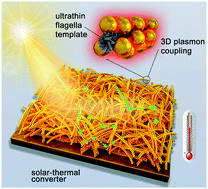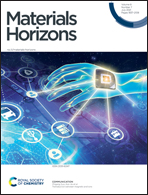3D Bacterial flagella as both synthetic biotemplates and ultrathin spacers for enhanced inter-particle coupling and solar energy harvesting†
Abstract
Linear light-absorbing nanomaterials are ideal for film-based solar harvesting applications as they form porous structures that can maximize the absorption and minimize the reflection of the solar light. Conventional 1D nanochains of plasmonic nanoparticle assemblies can achieve significantly broadened optical absorption through surface plasmon coupling, but their optical bands are still not broad enough to absorb through the solar spectrum and thus are not efficient solar absorbers. Here we discovered first by simulation that 3D structured nanochains of plasmonic nanoparticles presented a remarkably increased optical broadening effect and much longer redshift of the optical peaks due to the enhanced inter-particle coupling effect. Then we fabricated 3D nanochains by assembling gold nanoparticles (AuNPs) around 14 nm ultrathin bionanofibers, the bacterial flagella. The ultrathin biotemplates enabled the 3D arrangement of 50 nm AuNPs along the nanofiber with a very small inter-particle gap, allowing the strong coupling of surface plasmons in a 3D manner. Consistent with the theoretical prediction, the 3D nanochains, when assembled into films, could effectively convert nearly the full spectrum of solar energy into heat, which was further efficiently converted into electricity through a thermoelectric generation unit. Our work represents a nanobiomaterial approach to highly efficient solar thermal power generation.



 Please wait while we load your content...
Please wait while we load your content...
